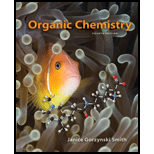
Concept explainers
Draw the products formed in each reaction.
a. ![]() f.
f. 
b. ![]() g.
g. 
c.  h.
h.
d.  i.
i. 
e.  j.
j. 
(a)
Interpretation: The product formed in the given reaction is to be drawn.
Concept introduction: The treatment of
Answer to Problem 26.32P
The product of the given reaction is,

Explanation of Solution
The given reaction involves treatment of an alkene with
The treatment of
The corresponding reaction is shown below.

Figure 1
Thus, the product of the given reaction is,

Figure 2
The product of the given reaction is drawn in Figure 2.
(b)
Interpretation: The product formed in the given reaction is to be drawn.
Concept introduction: The treatment of an organic halide with an alkene in the presence of
Answer to Problem 26.32P
The product of the given reaction is,

Explanation of Solution
The given reaction involves treatment of an organic halide with an alkene in the presence of
The treatment of an organic halide with an alkene in the presence of
The corresponding reaction is shown below.

Figure 3
Thus, the product of the given reaction is,

Figure 4
The product of the given reaction is drawn in Figure 4.
(c)
Interpretation: The product formed in the given reaction is to be drawn.
Concept introduction: The treatment of an organic halide with an alkene in the presence of
Answer to Problem 26.32P
The product of the given reaction is,
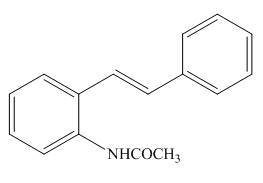
Explanation of Solution
The given reaction involves treatment of an organic halide with an alkene in the presence of
The treatment of an organic halide with an alkene in the presence of
The corresponding reaction is shown below.

Figure 5
Thus, the product of the given reaction is,

Figure 6
The product of the given reaction is drawn in Figure 6.
(d)
Interpretation: The product formed in the given reaction is to be drawn.
Concept introduction: The treatment of an organic halide
Answer to Problem 26.32P
The product of the given reaction is,

Explanation of Solution
The given reaction involves treatment of an organic halide with an organoborane reagent in the presence of
The treatment of an organic halide
The corresponding reaction is shown below.

Figure 7
Thus, the product of the given reaction is,

Figure 8
The product of the given reaction is drawn in Figure 8.
(e)
Interpretation: The product formed in the given reaction is to be drawn.
Concept introduction: The treatment of an organic halide
Answer to Problem 26.32P
The product of the given reaction is,

Explanation of Solution
The given reaction involves treatment of an organic halide with an organoborane reagent in the presence of
The treatment of an organic halide
The corresponding reaction is shown below.

Figure 9
Thus, the product of the given reaction is,

Figure 10
The product of the given reaction is drawn in Figure 10.
(f)
Interpretation: The product formed in the given reaction is to be drawn.
Concept introduction: The ring-closing metathesis (RCM) by Grubbs catalyst occurs, when the starting material is diene. This reaction is facilitated under high-dilution condition as it favors intramolecular metathesis instead of intermolecular metathesis.
Answer to Problem 26.32P
The product of the given reaction is,

Explanation of Solution
The given reaction involves treatment of a diene with Grubbs catalyst.
The ring-closing metathesis (RCM) by Grubbs catalyst occurs, when the starting material is diene. This reaction is facilitated under high-dilution condition as it favors intramolecular metathesis instead of intermolecular metathesis.
The corresponding reaction is shown below.
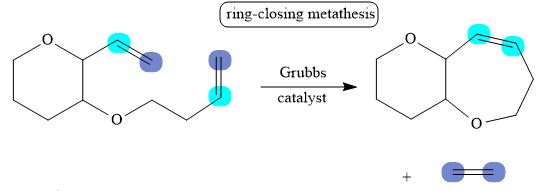
Figure 11
Thus, the product of the given reaction is,

Figure 12
The product of the given reaction is drawn in Figure 12.
(g)
Interpretation: The product formed in the given reaction is to be drawn.
Concept introduction: The nonhalogenated cyclopropanes are synthesized by the treatment of an alkene with
Answer to Problem 26.32P
The product of the given reaction is,

Explanation of Solution
The given reaction involves treatment of an alkene with
The nonhalogenated cyclopropanes are synthesized by the treatment of an alkene with
The corresponding reaction is shown below.

Figure 13
Thus, the product of the given reaction is,

Figure 14
The product of the given reaction is drawn in Figure 14.
(h)
Interpretation: The product formed in the given reaction is to be drawn.
Concept introduction: The treatment of
Answer to Problem 26.32P
The product of the given reaction is,
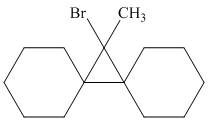
Explanation of Solution
The given reaction involves treatment of product formed in part (a) with
The dihalocyclopropane ring is converted to corresponding bromomethylcyclopropane by the treatment of given organocuprate reagent that is
The corresponding reaction is shown below.
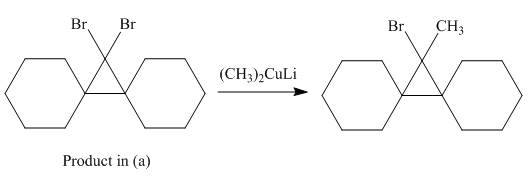
Figure 15
Thus, the product of the given reaction is,

Figure 16
The product of the given reaction is drawn in Figure 16.
(i)
Interpretation: The product formed in the given reaction is to be drawn.
Concept introduction: The treatment of an organic halide with
Answer to Problem 26.32P
The product of the given reaction is,
![]()
Explanation of Solution
The given reaction involves treatment of chlorobutane with
The treatment of an organic halide with
The corresponding reaction is shown below.

Figure 17
Thus, the product of the given reaction is,
![]()
Figure 18
The product of the given reaction is drawn in Figure 18.
(j)
Interpretation: The product formed in the given reaction is to be drawn.
Concept introduction: The treatment of an organic halide
Answer to Problem 26.32P
The product of the given reaction is,

Explanation of Solution
The given reaction involves treatment of an alkyne with an vinylborane, followed by treatment with organic halide in the presence of
The treatment of given alkyne with catecholborane leads to the formation of corresponding vinylborane in first step. This vinylborane (an organoborane) is formed by hydroboration which adds
The treatment of an organic halide
The corresponding reaction is shown below.

Figure 19
Thus, the product of the given reaction is,

Figure 20
The product of the given reaction is drawn in Figure 20.
Want to see more full solutions like this?
Chapter 26 Solutions
Connect Access Card For Organic Chemistry
- Draw the products formed when A or B is treated with each reagent. In some cases, no reaction occurs. [1] C6H5Li (excess); [2] H2Oarrow_forwardFill in the missing reagents a-h in the following scheme:arrow_forwardDraw a stepwise mechanism for the conversion of dihalide A and cyclohexane-1,4-diol to polyether B in the presence of AlCl3.arrow_forward
- Draw the products formed when A is treated with each reagent: (a) H2 + Pd-C; (b) mCPBA; (c) PCC; (d) CrO3, H2SO4, H2O; (e) Sharpless reagent with (+)-DET.arrow_forwardDraw the product(s) formed when A is treated with each reagent.a. NaBH4, CH3OH b. LiAlH4, then H2O c. Ag2O, NH4OH d. CrO3, H2SO4, H2O e. PCCarrow_forwardDraw the product formed when (CH3)2CHOH is treated with following reagent. H2SO4arrow_forward
- Draw the missing starting material. Reagent 1 is benzene and AlCl3. Reagent B is Zn(Hg) and HCl.arrow_forwardDevise a synthesis of each alkene using a Wittig reaction to form the double bond. You may use benzene and organic alcohols having four or fewer carbons as starting materials and any required reagents.arrow_forwardWhat product is formed when CH3OCH2CH2C ≡ CCH2CH(CH3)2 is treated with each reagent: (a) H2 (excess), Pd-C; (b) H2(1 equiv), Lindlar catalyst; (c) H2 (excess), Lindlar catalyst; (d) Na, NH3?arrow_forward
- Draw the products formed when A or B is treated with each reagent. In some cases, no reaction occurs.a. NaBH4, CH3OHb. [1] LiAlH4; [2] H2Oc. [1] CH3MgBr (excess); [2] H2Od. [1] C6H5Li (excess); [2] H2Oe. Na2Cr2O7, H2SO4, H2Oarrow_forwardDraw the organic product(s) formed when CH3CH2CH2OH is treated with each reagent. a.H2SO4 b.NaH c.HCl + ZnCl2 d.HBr e.SOCl2, pyridine f.PBr3 g.TsCl, pyridine h. [1] NaH; [2] CH3CH2Br [1] i.TsCl, pyridine; [2] NaSH j.POCl3, pyridinearrow_forwardEthers are oxidized with O2 to form hydroperoxides that decompose violently when heated. Draw a stepwise mechanism for this reaction.arrow_forward
 Organic Chemistry: A Guided InquiryChemistryISBN:9780618974122Author:Andrei StraumanisPublisher:Cengage Learning
Organic Chemistry: A Guided InquiryChemistryISBN:9780618974122Author:Andrei StraumanisPublisher:Cengage Learning

